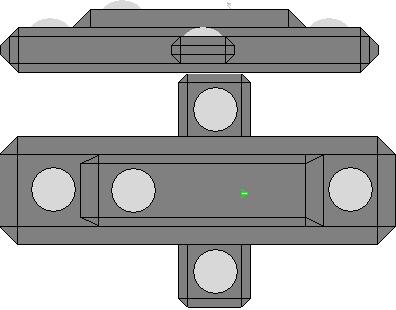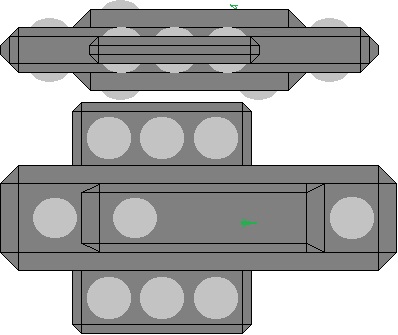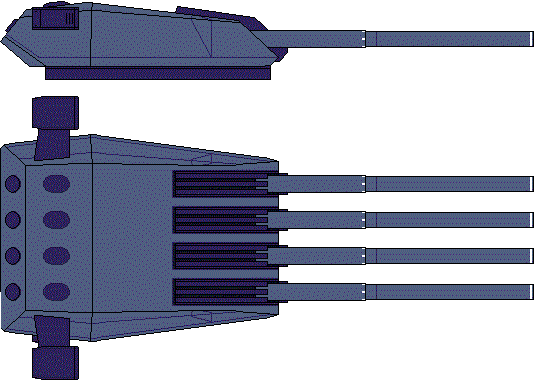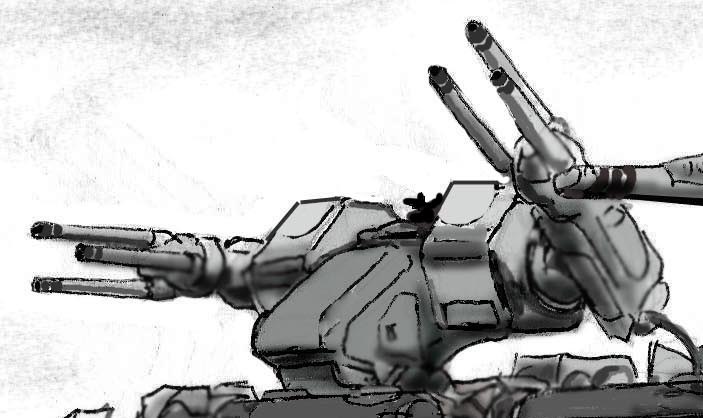
United Galaxies Council. | FOLKER-Class Battle Landship. | 
United Galaxies Council. |
|---|
REF Field Commanders (Colonel and above) needed a mobile HQ that could keep up with the front lines, but also be reasonably able to either fight their way out of trouble or run away if necessary. At first, Raidar X and Spartan  | FOLKER-Class Battle Landship line drawings, portside
and above. The green spot is a VT (for scale). |
|---|
torsos were simply mounted on the hull of standard ELEPHANTS; Starting in 2079, however, a program was tested in which the old USS IOWA was set on specially-built supports, called "saddles," on the deck of an ELEPHANT to test the plausibility fo the design. Other than a few structural flaws (related to the design of the ELEPHANTS), the concept prover was a complete success.The next step was UES FOLKER; She floated at Johannesburg Shipyards, 11 MARCH 2082. An classic 4 in-line turret design, she was armed, at first, with 2 quad 40CM turrets (exactly like the MAC II; #1 and 3) and 2 T'sentraedi light laser turrets (#2 and 4).An immediate problem was realized: When fired, the 40CM turrets would cause a list up to 40 degrees; The T'sentraedi laser turrets couldn't fire behind line-of-sight. This was solved 3 ways: First, all four turrets were replaced with the then new and experimental Model-14 Rail Launcher Turret. These produced 10% of the recoil as the 40CM, even firing full broadside. Second, super-powerful ducted fans were installed all along the hull; Computer co-ordination reduced the recoil to and easily ignored 5 degrees. Third, ultra-fast deploying legs were installed to allow use in zero-atmosphere environments, though the deploying of these reduced the initial and last volley (when used, reduce the First and last volley by one attack FOR THAT MELEE); While used, the vessel is unable to move forWard or backWard, though it can spin on the leg ("twisting" as it's called).Only 3 "quaddies" (4-turreted) were ever built; FOLKER, DIXON, and MASON. MASON was later upgraded to the 5-turreted "quint" type more popular now. LBB-05 ELLIS and beyond have all been quints. A second version of the FOLKER, the HUNTER-Class, was developed for use in space. They have since been decommisioned, but the FOLKER-Class are still in use in an unmaned version by the Spacy and Patrol.FOLKER-Class Upgrade Program:As the focus of UGC operations switched from strongly orbital to strongly surface, an upgrade to the FOLKER-Class was considered by stretching out the outriggers and "mirroring" the hull dorsal and ventral. This increased  | | FOLKER-Class Battle Landship Upgrade. |
|---|
the number of main turrets from 5 to 17; It also increased the crew requirements.The program isn't as awesome as some thought it would be, but the increased firepower proved highly valuable, especially in orbital confrontations; These tiny boats were effectively heavy cruisers by punching weight.Upgrading the entire fleet is clearly cost-prohibitive (and not cost effective), but no more traditional FOLKER-Class are being built; Only FOLKER U-Class are, at the rate that FOLKERS are being decommissioned plus the rate they were being built beforehand. The orbital variant are manned, unlike the HUNTER-Class, but minimally, and in a hardened 'bunker' deeper in the ship. (It's actually the standard configuration, but the turrets themselves are manned in an atmosphere, remotely operated in orbit with only a +3 strike.) The FOLKER-U2a moved the ourriggers more center to the ship, removed the always debatable substructure (which had proven to be needlessly vulnerable to groundfire in any case), and added retractable fore and aft panels making the vsl more seaworthy (they tended to catch the water, drawing the ships off course). Depicted is one of the pre-U2a of which only 1,000 were built (of the 40,000 or so that were already in service at that point).FOLKER-Class Limitations:Many people mistakenly think of the FOLKER-Class as a kind of ultra-heavy tank, like the ancient Tiresian Ruger tanks or Terran Ratte Tank; Nothing could be further from the truth. The FOLKER-Class is in fact totally unsuitable for combat against Mecha, tanks, power armored infantry, or even some non-PA specialist infantry. Though the smallest weapons on a FOLKER is bigger than any Mecha's total weapons combined (short of the HAS-Series of the MAC-Series they came from), they can't effectively engage those targets due to the small size. Half the time, they can't even see a target that small. Only saturations firing/bombing can effectively engage such targets, and by definition only by bombing everything in 1,000 feet in the area. These ships are therefore DEEPLY dependent upon their own Mecha and Fighter escorts to protect them.Where the FOLKER excels is engaging other ships, such as assault shuttles, preventing a successful landing to begin with, in anti-fighter defense and screening force for battle fleets, and escorting assault shuttles during an assault. They "can" provide fire support for infantry (their main turrets are vaguely based on the ancient MAC-II), and will if the circumstances permit it, but are not generally suitable for engagement of anything closer than a half a mile in range and 30 feet in height.Name: FOLKER-Class.Model Type: Battle Landship.Crew:Officers: About 30.Enlisted: About 400.Passengers: None normally, though "specialists" are occasionally assigned to the ship.MDC By Location: |
Hull-
Bridge compartment-
On Water Props (4)-
M-14 Turrets (5)-
MRM Launchers (20)-
M-16 Turret Gunners Compartment-
M-16 Turret Upper Arms (2)- | 50,000
1,000
700 each
500 each
300 each
300
150 each | M-16 Turret Laser Barrels (6)-
M-16 Turret MRM Launchers (2)-
M-16 Turret Gatling Gun-
M-16 Turret Head-
M-16 Turret Head Lasers (5)-
M-16 Turret Radar Array-
Anchor Cables 10)- | 100 each
150 each
100
100
30
100
20 each |
| Note: Usual conditions apply.Speed and Statistical Data: |
Maximum Hover Speed: 40 knots.
Maximum Hover Ceiling: Operationally they fly at 100 feet; However, they are independently transatmospheric.
Maximum Sailing Speed: 20 knots.
Range In Hover: No limit; You could easily raise the anchors and continuously cruise forever.
Height: From keel to top of #2 turret is 60 feet; 10 deck altogether.
Beam:Hull: 25 feet;Outriggers: 150 feet.
Length: 250 feet.
Weight: 2,000,000 tons.
Cargo: 2 tons of cargo can be carried if CRITICALLY necessary.
Displacement: 600,000 tons.
Power System:Primary: SRO-04nk Reflex Furnace; Output: 2,500 KWh at 100,000 hsp; Lifespan: 20 years.Secondary: HCS-413 Hydro-Cell Scram Jets Engines; Output: 20,000 hsp at 39,000 pounds thrust; Range: Lifespan: 40,000 nautical miles.Tertiary: Solar Sails; Also can be used for wind sailing; Output: 1,200 KWh at 65,000 hsp; Lifespan: Unlimited. | Power System (con't):Quariary: Reserve Batteries; Used for emergency power and at night if running low-power (basically hovering at anchor); Output: 700 KWh at 5,000 hsp; Lifespan: 400 hours before serious drain shows; will usually last another 40 before grounding/stalling at sea. NOTE: This is by no means a primary power source; The batteries MUST be recharged as often as possible.
Flight Systems: Grav Pods.
Thrust Systems:Primary: KKS-451 Traction Drive; Output: 21,000 hsp at 43,000 pounds thrust; Range: Unlimited.Secondary: Bleed off from Hydro-Cell scram jets.Tertiary: Solar Sails; Output: Varies GREATLY by weather conditions; Range: Unlimited if favorable weather.Quartiary: 4 screw propellers; Only useful in the water. Output: 10,000 hsp at 25,000 pounds thrust; Range: Unlimited.
Hull Life: 200 years before SLEP, 250 after.
Cost and Availability: 500 millioncredit; 6 months to 1 years at a shipyard.
Black Market Cost and Availability: They can be had for a "reasonable price" of roughly 50,000 to 50 billioncredit on an almost constant basis.
|
| Weapons Systems: |
|---|
 | | Generation 5 Style Turret. |
|---|
1. Model-14 Rail Launcher Turret: 04 MRM Rail Launchers in a normal, vaguely tank-shaped turret, positioned 2 forward, 1 aft, and one on either outrigger wing. Only 1 type of missile is currently in use, the SSRA-500 HEAP X (a tenth generation High Explosive Armor Piercing) missile. These rail launchers have auto-loaders, allowing for a GREATLY increased rate of fire.
Purpose: Offensive/Anti-Ship/Fortress
MD: 4D6 times 10
Blast Radius: 60 feet
Maximum Range: 80 miles
Rate of Fire: 3 per launcher (barrel) per melee.
Payload: 2,000 MRMs
Bonus: Using helicopter, fighter, or another ships targeting system the missile is +3 to strike. Using a combination of 2, it gains a +5 (only 2 can be combined).
 2. Model-16 Anti-Aircraft Turret: Based on the upper body of the Mecha Knight Destroid, each FOLKER has 14 of these anti-aircraft turrets, one on top of each M-14 turret and 3 along each side of the superstructure and the dorsal side of the hull. Each has 4 types of weapons: A pair of Laser Cannon "arms," "shoulder" missile launchers, quintary head lasers, and a "belly" 20MM, 5-barreled Gatling guns for anti-missile defense. Special bonus: The turret has it's own built-in fixed forWard radar, giving it +2 to strike. Loss of this radar negates this advantage, but the guns and missiles can still be trained by information from the Combat Information Center. Additionally, the 3 dorsal turrets are retractable to allow ease of landing. 2. Model-16 Anti-Aircraft Turret: Based on the upper body of the Mecha Knight Destroid, each FOLKER has 14 of these anti-aircraft turrets, one on top of each M-14 turret and 3 along each side of the superstructure and the dorsal side of the hull. Each has 4 types of weapons: A pair of Laser Cannon "arms," "shoulder" missile launchers, quintary head lasers, and a "belly" 20MM, 5-barreled Gatling guns for anti-missile defense. Special bonus: The turret has it's own built-in fixed forWard radar, giving it +2 to strike. Loss of this radar negates this advantage, but the guns and missiles can still be trained by information from the Combat Information Center. Additionally, the 3 dorsal turrets are retractable to allow ease of landing. | 5. Special Loads: The vessel can also carry SOME aircraft wing-mounted weapons in a ventral bomb-bay like compartment.
A) XM-11 Torpedo Pod: An ASW torpedo pod. Carries the Mk-82 Airborne Torpedo, essentially a modified version of the Mk-81 Submarine Launched Torpedo. The initial launch is by a nothing so complicated as releasing it from the latches that hold it to the pylon. The on board hydro-cell motor then takes over as soon as the torpedo splashes. Each pod hold 3 Mk-82's.
Purpose: Offensive/Anti-Ship
MD: 4D6 times 10 per torpedo
Blast Radius: 40 feet
Maximum Range: 80 miles
Minimum Range: 5 miles
Rate of Fire: 1 torpedo per pilots attacks per melee.
Payload: Each pod holds 3 Mk-82's.
B) XM-14 Sonar Buoy Pod: An air-droppable sonar buoy used to assist in detecting and tracking incurring submarines for future reference.
C) XM-17 Depth Charges: Used for hunting submarines. Automatically launches.
Maximum Effective Range/Depth: Varies by input. The gunner who's immediately using it sets it to the depth he wants it to detonate at, then sets what will set it off (may be the depth, or some specific target or type of target).
MD: 2D6 times 10 per blast.
Blast Radius: 40 feet
Rate of Fire: Per gunner's attacks per melee.
Payload: 200 total.
6. Mine Layer: Probably the ship's single nastiest weapons system, the mine layers is capable of not only dropping to the ground, but actually BURYING mines anywhere from 2 inches to 2 FEET deep with little disturbed ground to expose the location (the ground will fully heal over in about 4 days with rain, or 2 weeks without). -10% to detect concealment, -5% detect mines (unless mine detection equipment is used).
Maximum Depth of mines: 2 feet
Mega Damage: 6D6 per mine.
Blast Radius: 40 feet
Rate of Fire: Only once.
Payload: 200 mines can be laid before more must be brought on board.
7. Type XM-19 Depth Charge Dropper (2): An automatic XM-17 Depth Charge Dropper used to harass submarines. The actual container for the depth charge is a modified version of a 20-gallon fuel drum. The droppers are located either side of the hull amidships. The racks that hold the depth charges are inside the hull; The depth charge is brought up on deck by a chain system, and then dropped over the side.
Purpose: Anti-Submarine
MD: 3D6
Rate of Fire: 3 XM-17's can be dropped per launcher per melee.
Diving Range: From 10 feet to 150 feet.
Payload: 100 per launcher (200 total). Another 400 CAN be carried on board and manually loaded into the rack (takes 2 melee actions per drum).
8. Mecha And Vehicles: Each of these vessels carry an EXTENSIVE amount of Mecha:REF Escalators and Valiants: 30Guardians and Veritechs: 10Tanks and APCS: 10Cyclones and other Power Armors: 100
9. Crews Weapons: No sailor worth his grog would be without a knife, and every manner of weapon has been found on these vessels, most strictly forbidden to civilians.
10. Cutting Stick: Essentially nothing more than a blunt-tipped, heavily serrated knife on an approximately 3 foot pole. Ideal for cutting lines without getting too close.
Purpose: Cutting line under tension.
Damage: 1D4 SD; No PS bonuses apply.
Range: 1 to 3 yards, depending on who made it and what mood he was in at the time.
Attacks per melee: Per user.
Payload: Unlimited (until some asshole breaks it). For more information click HERE. |
A) Laser Cannons (6): Based on the laser cannons on the Raidar X, these are the main weapon of the turret. NOTE: These guns fire in tandem, like pom-pom guns. If one barrel is damaged, reduce the damage and rate of fire FOR THAT ARM by a Third. Each gun must be targeting the same object as the other (can not be independently targeted).
Purpose: Anti-Aircraft/Ship.
MD: 2D10 short burst, 4D10 medium burst, or 6D10 long burst.
Rate of Fire: 8 short, 4 medium, or 2 long bursts per arm per melee per gunner's attacks per melee.
Range: 08 miles.
Payload: Unlimited.
B) MRM Launcher Shoulders (2): A pair of MRM launchers mounted at the approximate position as the shoulders.
Purpose: Anti-Ship/Aircraft.
Missile Type: Medium Range.
Rate of Fire: Volleys of 1, 2, 3, 4, 6, 12 or all 24 per gunners attacks per melee.
Payload: 24 per launcher (48 total); Reloading takes about 5 minutes for a full reload (10 missiles take about 1 melee).
| C) Quintary Head Lasers: Toggled directly to the gunners eyes, this weapon shoots where they see. Based directly off of the old VF-1 lasers, there are 5 lasers, arranged in the lesser-known Zulu configuration.
Purpose: Anti-Missile Defense.
MD: 5D6 per blast.
Rate of Fire: Per gunners attacks per melee.
Range: 2,000 feet.
Payload: Unlimited.
D) 20MM Vulcan Gatling Gun: This gun is actually automated. The gunner activates the weapon by flipping a red switch under a cover on the control panel. The gun can NOT tell friend from foe, only whether an object is closing with the ship and how fast it is moving. If it meets certain criteria, the gun fires, throwing a wall of lead that either shreds the missile OR causes it to prematurely detonate.
Purpose: Anti-Missile Defense.
MD: 5D6 per 10 round blast.
Rate of Fire: Up to 6 per melee.
Range: 6,000 feet.
Payload: 6,000 rounds (600 bursts). Reloading takes 20 minutes.
|
3. Vertical Launch Missile Launcher: A vertical LRM launcher is located on the dorsal side of the hull.
Purpose: Anti-City
Missile Type: Long Range
Rate of Fire: Volleys of 1, 2, 3, 5, 10, 15, or all 30 per missilers attacks per melee.
Payload: 30 LRM's; Must be reloaded with special equipment (though it can be done by a EMIL LANG-Class repair ship).
4. Ramming: The FOLKER-Class is equipped with a reinforced bow, allowing the ship to ram an enemy as a last resort.
Purpose: Anti-Ship
MD: 1 MD per MPH; The FOLKER takes 1 MD per 100 inflicted.
Attack Per Melee: Once per every OTHER melee.
Payload: CONDITIONALLY UNLIMITED; The bow must be repaired after using this attack, but as long as it is, it can be used indefinitely. |
| Features: |
- Radar: Combat grade radar. Range 100 miles, can track up to 50 individual targets. 95% reliability (24% against unfriendly stealthed vehicles). The ships STILL have the civilian grade radar as well.
- FLIR/SLIR: ForWard and Side Looking Infrared. Allows pilot to get visuals on targets at night.
- AJP: Active Jamming Pod. Causes -25% to detection but when it is active, other vehicles/bases can detect that it is jamming, and some missiles will home in on jamming signals. Jamming also causes a -4 penalty to all radar guided weapons. The jamming pod is mounted on the mast.
- AMC/FD (2): Anti-Missile Chaff/Flare Dispensers. Actually launches a glob of burning magnesium/aluminum alloy to confuse both radar AND heat sensory systems. Fires off 04 chaff/flares each time it is activated. The system is KNOWN to work on all KNOWN radar and infrared systems, but concerns continue that somewhere out there their MIGHT be a system that will be totally unaffected by the system. Reduce effects by 20% against smart missiles (add +20% to rolls for smart missiles).
- Effect:
- 01-50 Enemy missile or missile volley detonates in chaff cloud- Missiles are all destroyed.
- 51-75 Enemy missile or missile volley loses track of real target and veers away in wrong direction (may lock onto another target).
- 76-00 No effect, missile is still on target.
- Also note that the chaff cloud will also blind nearby heat sensors (and optically based sensors at night) for 1 melee. They will suffer the following penalties: Reduce melee attacks/actions, and combat bonuses by half.
- Duration: 1D4 melee rounds.
- Payload: 60 chaff/flares. Each time the system is engaged, the system fires off 04 chaff/flares.
- Optic Systems: Infrared: 20 miles, Magnification: 15 times; Ultra Violet: 22 miles, Magnification: 25 times; Night Vision: 24 miles, Magnification: 8 times; Color Filters: 19 miles, Magnification: 200 times
- ESM: Radar Detector. Passively detects other radars being operated.
- Radar: Civilian grade radar. Range 50 miles, can track up to 25 individual targets. 95% reliability (00% against unfriendly stealthed vehicles).
- GPS: Standard tracking device. Ties into the Blue Force Tracker.
| - Blue Force Tracker: Identifies friend from foe. Overlays the information on both the radar and HUD, ensuring that friendly forces are not accidentally targeted.
- Anti-Jamming System: Reduces Electronics Countermeasure by 3/4 (decrease skill level appropriately).
- HUD: Displays maps, radar, targeting information, and any OTHER information the wearer wants directly in front of the user.
- Video Camera: Records from the HUD and HDD. 50 hours of recording available.
- Virtual Map: Displays a continuously-updating map of local terrain for the pilot. Takes data from other friendly units in the area. Effective land navigation of 85% as updates come. Good to 500 miles. Specific range can be adjusted in 1 mile increments.
- LDP (4): Launched Decoy Pods. Located on the fantail. The ships carry a special pod that carries four advanced launched decoy drones, specially designed lures that creates a radar image to mimic the ship. This system has been successfully deployed against SEVERAL alien radar-type sensors (including one that works off of sound), but have no effect on Invid Protoculture sensors.
- M.D.C.: 5
- Effects: The decoy has a 98% chance of fooling ordinary non military radars and non smart guided missiles, and a 90% chance of fooling military grade radars and advanced smart missiles.
- Range: Released to go wherever it wants. Can fly independently for about 30 minutes.
- Rate of Fire: Per pilots attacks per melee.
- Payload: 16 Decoys total.
- Survival Pack: A pack of simpler emergency survival supplies: Sleeping bag, black light, GPS, 1ˢᵗ aid kit (bandages, gauze, bandage tape, pads, antiseptic/analgesic), plasma torch (for small repairs and starting fires), repair kit (with MDC Repair Spray), sewing kit (a small spool of thread and 5 needles), 7 star flares (250 foot apogee), 7 white parachute flares (1,500 foot apogee), 100 feet of black or brown parachute cord (150 lbs tensile strength), 2-5 days rations, 2 gallons water, water purification kit (good for about 10 gallons), manual-inflating liferaft (for at-sea abandonment), self-inflating lifevest (15# buoyancy). The liferaft can double as a Pup Tent if so desired (though most pilots prefer to use a parachute for that, if anything, due to the fact that it is easier to hide).
|
Combat Bonuses from FOLKER-Class Combat Elite:- 4 additional attack per melee.
- One additional Attack Per melee at levels 3, 6, 12, and 15 with any additional bonuses for the crew.
- +5 Initiative.
- +6 Strike.
- +4 Roll.
- +5 Dodge
|


 2. Model-16 Anti-Aircraft Turret: Based on the upper body of the Mecha Knight Destroid, each FOLKER has 14 of these anti-aircraft turrets, one on top of each M-14 turret and 3 along each side of the superstructure and the dorsal side of the hull. Each has 4 types of weapons: A pair of Laser Cannon "arms," "shoulder" missile launchers, quintary head lasers, and a "belly" 20MM, 5-barreled Gatling guns for anti-missile defense. Special bonus: The turret has it's own built-in fixed forWard radar, giving it +2 to strike. Loss of this radar negates this advantage, but the guns and missiles can still be trained by information from the Combat Information Center. Additionally, the 3 dorsal turrets are retractable to allow ease of landing.
2. Model-16 Anti-Aircraft Turret: Based on the upper body of the Mecha Knight Destroid, each FOLKER has 14 of these anti-aircraft turrets, one on top of each M-14 turret and 3 along each side of the superstructure and the dorsal side of the hull. Each has 4 types of weapons: A pair of Laser Cannon "arms," "shoulder" missile launchers, quintary head lasers, and a "belly" 20MM, 5-barreled Gatling guns for anti-missile defense. Special bonus: The turret has it's own built-in fixed forWard radar, giving it +2 to strike. Loss of this radar negates this advantage, but the guns and missiles can still be trained by information from the Combat Information Center. Additionally, the 3 dorsal turrets are retractable to allow ease of landing.

